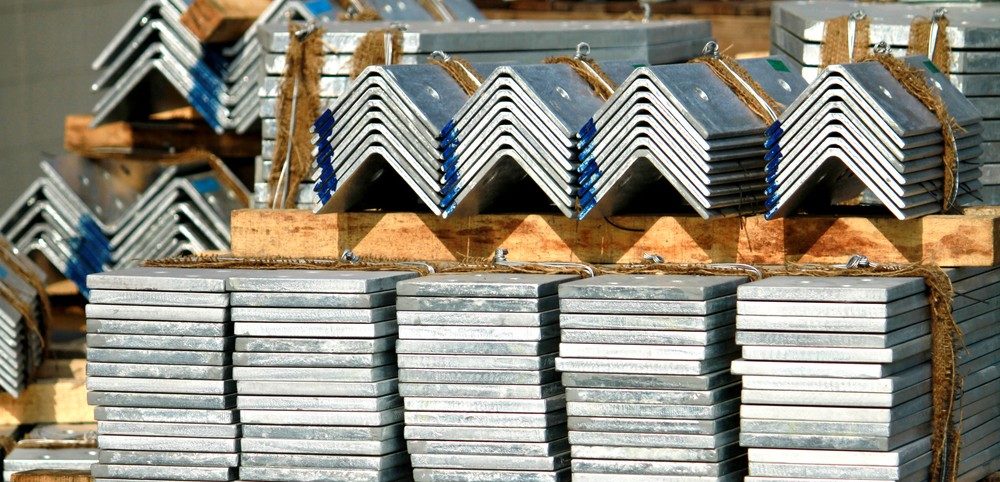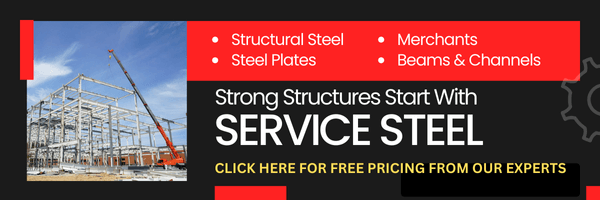What is A36 Steel? Composition, Properties, and Uses
June 27, 2025 | Categorized in: Types

A36 steel is a standard structural steel grade specified by ASTM for its strength, weldability, and versatility. It is a low-carbon, hot-rolled steel commonly used in construction and fabrication. Known for its consistent performance and affordability, A36 is one of the most widely used steel grades in the United States.
Whatever steel merchants you need, from angles, flats, rounds, to channels, A36 delivers dependable results at an economical price point. It is typically hot-rolled, giving it a rugged finish, and is available in a broad range of shapes and thicknesses to meet just about any project requirement.
A36 Steel Composition
When it comes to what this type of steel is made of, A36 is classified as a low-carbon steel, which plays a big role in how it’s used and how it performs. With a max carbon content of 0.26%, this grade is easier to weld, cut, and shape than higher-carbon alternatives. It also includes manganese, phosphorus, and sulfur in controlled amounts, each contributing to the steel’s overall strength and machinability.
Here’s a quick breakdown of A36 steel’s composition:
|
Element |
Content (%) |
|
Carbon (C) |
≤ 0.26% |
|
Manganese (Mn) |
0.60–0.90% |
|
Phosphorus (P) |
≤ 0.04% |
|
Sulfur (S) |
≤ 0.05% |
|
Iron (Fe) |
Balance |
A36 Steel Properties
A36 steel is valued for its practical balance of toughness, ductility, and strength. Most commonly, A36 is produced as hot-rolled steel. This gives it a scaled, rougher surface and makes it easier and more affordable to manufacture in large volumes. Cold-rolled versions are also available, offering a smoother finish and tighter dimensional accuracy, which can be beneficial in applications where surface appearance or precision matters. Whether you’re bending, welding, or cutting steel, A36 offers the kind of versatility that simplifies fabrication while still delivering reliable performance.
A36 Yield Strength
The yield strength of A36 steel is approximately 36,000 psi. Yield strength refers to the amount of stress the material can handle before it begins to deform permanently. For structural steel, this level of strength makes A36 ideal for frames, supports, and other elements that need to remain stable under pressure without being brittle.
A36 Tensile Strength
A36 steel typically has a tensile strength ranging from 58,000 to 80,000 psi. Tensile strength measures the point at which the material will break under tension. This broad range gives A36 flexibility across different applications, allowing it to handle both static and dynamic forces in construction and industrial settings.
A36 Steel Density
The density of A36 steel is approximately 0.284 pounds per cubic inch. This is standard for carbon steels and makes it easy to estimate weight, load capacity, and shipping requirements when planning structural or mechanical projects.
A36 Steel Melting Point
A36 steel has a melting point close to 2,600 degrees Fahrenheit, or around 1,427 degrees Celsius. This high melting temperature is typical of low-carbon steels and ensures that A36 can be safely welded, heat-treated, or used in high-temperature environments without losing structural integrity.
What is A36 Steel Used For?
A36 steel is used across a wide range of industries as it’s one of most versatile steel grades on the market. Its combination of formability, strength, and affordability means it shows up in everything from steel buildings to heavy-duty equipment frames. Some of the most common A36 applications include:
- Steel merchants such as angles, flats, rounds, or channels
- Steel plates, bars, and angles for general fabrication
- Steel frames for construction equipment and trailers
- Brackets, gussets, and reinforcement components
- Industrial tanks, walkways, and supports
- Agricultural machinery and building infrastructure
A36 Steel FAQs
What Does A36 Steel Mean?
A36 steel gets its name from the ASTM (American Society for Testing and Materials) specification that governs it: ASTM A36. This specification outlines the material’s required chemical composition and mechanical properties, specifically for carbon structural steel. It’s one of the most commonly used steel grades for structural applications in the United States.
- The “A” stands for a ferrous (iron-based) metal
- The number “36” refers to its minimum yield strength (36,000 psi).
Is A36 Mild Steel?
Yes, A36 is considered mild steel. It falls into the low-carbon category with a maximum carbon content of 0.26%. This makes it more ductile and easier to weld, cut, and shape compared to medium- or high-carbon steels. While the A36 steel hardness doesn’t offer the same as some alloy steels, its low carbon content provides a good balance of strength and formability, making it ideal for general structural applications.
What Grade is A36 Steel?
A36 is a standard structural steel grade, specifically defined by ASTM for carbon steel. It is typically available in hot-rolled form, although cold-rolled options exist for tighter tolerance needs. As a structural-grade material, it’s used in everything from building frameworks and bridges to heavy equipment. It is classified as a carbon steel but doesn’t fall under alloy steel designations, as its chemical content is relatively simple and cost-effective.
What is the Difference Between A36 and A572 Steel?
The main difference between A36 and A572 steel is strength and alloy content. A572 is a high-strength, low-alloy structural steel that offers better mechanical performance, particularly in terms of yield strength and tensile strength:
- Strength: A572 is a high-strength, low-alloy steel with a yield strength of 50,000 psi—significantly higher than A36’s 36,000 psi.
- Performance: A572 offers better resistance to corrosion and fatigue, making it ideal for demanding applications like bridges and heavy construction.
- Workability: A36 is easier to weld, machine, and shape, and is more cost-effective for everyday structural use.
Get High-Quality A36 Steel for Your Next Project
A36 carbon steel is a go-to material for a reason. It delivers the right mix of strength, formability, and affordability, making it a practical solution for a wide range of structural and fabricated steel applications. Whether you’re sourcing material for new construction or keeping up with maintenance and repairs, A36 gets the job done.
At Service Steel Warehouse, we keep a deep inventory of A36 steel ready to ship and we’ve built a reputation on premium quality and exceptional service. We ensure that every steel product meets rigorous ASTM steel standards and exceeds expectations. Explore our extensive inventory of structural steel, all ready-to-ship for your projects. Request a free quote or give us a call today!

